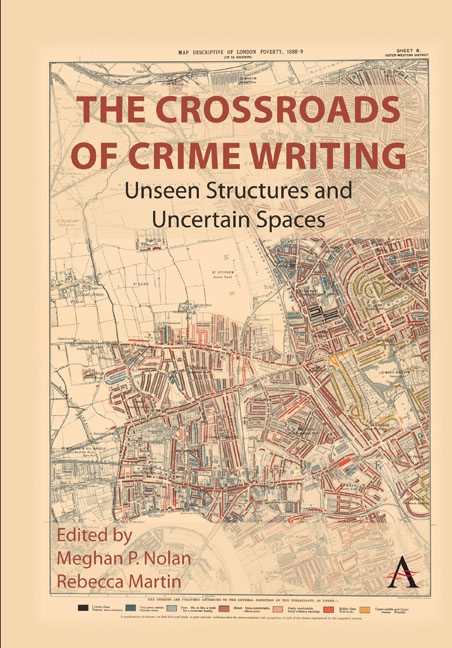Book contents
- Frontmatter
- Contents
- Introduction
- Unseen Structures
- Chapter 1 Unseen Structures and the Outlaw: Depictions of Violations in Stieg Larsson’s Millennium Trilogy
- Chapter 2 Dark Waters: Eco-Noir in New York 2140
- Chapter 3 Between Lenin and Sherlock Holmes: Soviet Militsiya Procedural in Volodymyr Kashin’s Detective Fiction
- Chapter 4 Detecting Justice: Black Crime Fiction and the Novels of Attica Locke
- Chapter 5 The Police and the Private Eye: The Making of Gendered and Racial Peripheralization in the Crime Fiction of Valerie Wilson Wesley
- Uncertain Spaces
- Chapter 6 Navigating the Carceral City: Calcutta in Late Nineteenth-Century Narratives of Detection
- Chapter 7 Traversing the Borders of Poverty and Morality: The Intersection of Maps and Upper-Class Ethics in Anne Perry’s Neo-Victorian Series
- Chapter 8 Facts and Fictions: The Liminal Space Between True Crime and Crime Fiction
- Chapter 9 The Success(Ion) and Corruption of Crime Genres in Jo Nesbø’s Macbeth (2018)
- Chapter 10 The Golden Age Meets the Age of Aquarius: Agatha Christie in the 1960s
- Notes on Editors and Contributors
- Permissions
- Index
Chapter 2 - Dark Waters: Eco-Noir in New York 2140
Published online by Cambridge University Press: 13 April 2024
- Frontmatter
- Contents
- Introduction
- Unseen Structures
- Chapter 1 Unseen Structures and the Outlaw: Depictions of Violations in Stieg Larsson’s Millennium Trilogy
- Chapter 2 Dark Waters: Eco-Noir in New York 2140
- Chapter 3 Between Lenin and Sherlock Holmes: Soviet Militsiya Procedural in Volodymyr Kashin’s Detective Fiction
- Chapter 4 Detecting Justice: Black Crime Fiction and the Novels of Attica Locke
- Chapter 5 The Police and the Private Eye: The Making of Gendered and Racial Peripheralization in the Crime Fiction of Valerie Wilson Wesley
- Uncertain Spaces
- Chapter 6 Navigating the Carceral City: Calcutta in Late Nineteenth-Century Narratives of Detection
- Chapter 7 Traversing the Borders of Poverty and Morality: The Intersection of Maps and Upper-Class Ethics in Anne Perry’s Neo-Victorian Series
- Chapter 8 Facts and Fictions: The Liminal Space Between True Crime and Crime Fiction
- Chapter 9 The Success(Ion) and Corruption of Crime Genres in Jo Nesbø’s Macbeth (2018)
- Chapter 10 The Golden Age Meets the Age of Aquarius: Agatha Christie in the 1960s
- Notes on Editors and Contributors
- Permissions
- Index
Summary
Introduction
When Hexter from Kim Stanley Robinson's New York 2140 talks about a novel he has written, he describes it as “mostly a detective novel, I guess you’d say, or an adventure novel where it's just one damn thing after another” (Robinson 2017, 392). One of the pitfalls in emulating traditional action-packed noir and hardboiled narratives, both subgenres of crime fiction, is that one can run into the problem of reducing the work to a pure thriller. Consequently, a pure thriller narrative, which can include psychological, action, and crime thrillers, might make it difficult to effectively address societal, political, and other issues. Rather than writing another pure dystopic, science fiction thriller, Robinson is more interested in coupling noir/hardboiled1 and cli-fi genres to comment on environmental degradation because, as he argues in the afterword of Green Planets, “it's only when you shrink the novel to the thriller that you run into problems in representing ordinary realities” (Canavan and Robinson 2014, 245).
In this chapter, I examine the relationship of New York 2140 with traditional hardboiled noir texts of the 1920s–1940s by Dashiell Hammett and Raymond Chandler. Specifically, I examine the relationship between the hardboiled and Anglo-hypermasculine noir narratives of early twentieth-century America and the rhizomatic dystopian and utopian ecology of New York 2140. Although noir has an uncanny capacity to draw the reader's attention to the scenic and the setting of our environment, it does so in limited ways. While the landscape in classic noir texts remains secondary to the plot and action, New York 2140 places the landscape at the heart of the narrative in order to raise awareness of climate change. In short, New York 2140 reenvisions conventions of violence, crime/criminals, and victims found in noir narratives to elicit action from readers against environmental degradation.
In New York 2140, Robinson depicts a near future of the planet suffering from sea level rise due to a warming climate. Unique to this novel is the fusion of dystopian and optimist outlooks on our future. In this novel, New York City is the new Venice, canals replace streets and we read about how people adapt to these changes.
- Type
- Chapter
- Information
- The Crossroads of Crime WritingUnseen Structures and Uncertain Spaces, pp. 41 - 62Publisher: Anthem PressPrint publication year: 2024



